Sunbeam BM3500 User Manual
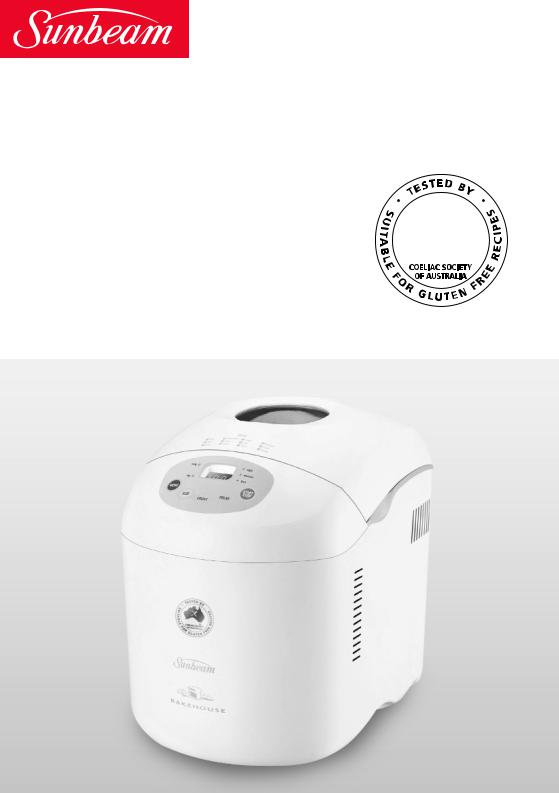
Bakehouse
Automatic dough & bread maker
Instruction/Recipe Booklet
BM3500
Please read these instructions carefully and retain for future reference.
Congratulations
Fresh, warm home made bread is just a few easy steps away with your new Sunbeam Bakehouse.
With your new Bakehouse you can have delicious home made bread in under 2 hours. And your only limited by your imagination......
salami and cheese bread, soy and linseed bread, bacon and beer bread, pasta, doughs and specialty breads...the variety is endless! You can also make your favourite jam, cakes and hot cross buns!
And it really is as easy as 1....2....3! Step 1. Remove the bread pan from the breadmaker and add the ingredients.
Step 2. Position the bread pan and select the desired program setting.
Step 3. In a few hours, freshly baked bread is ready to enjoy.
Imagine waking up to the aroma of freshly baked bread. This is so easy to do because your Bakehouse has a 15 hour pre-set timer. Set it the night before and wake up to the aroma of freshly baked bread.
Before you start, read all the instructions in this book to ensure you get the most from your breadmaker.
We’ve done everything we can do to make bread baking a breeze, but if you have any concerns regarding the performance and use of your breadmaker, please call....
Sunbeam Customer Service (toll-free)
Australia |
1800 025 059 |
New Zealand |
09 912 0747 |
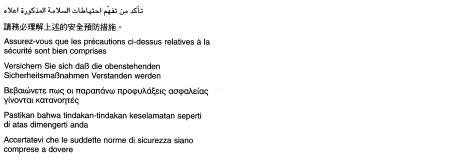
Contents
Sunbeam’s Safety Precautions Using your Bakehouse safely Getting to know your Bakehouse The Control Panel
Program Settings
Role of ingredients
What ingredients to use
Using your Bakehouse
Select Program setting
Using the Time Delay Function
Turbo, Cake, Jam, Bake, Damper, Pasta & Dough settings
Power Interruption Program Protection
Important Measuring Tips
Handy Hints
Care & Cleaning, Help Guide
1 |
Recipes: |
|
|
2 |
Bread Mix |
20 |
|
White bread |
22 |
||
4 |
|||
Turbo |
26 |
||
6 |
|||
Wheat bread |
29 |
||
7 |
Sweet bread |
32 |
|
8 |
French bread |
36 |
|
Gluten Free bread |
38 |
||
9 |
|||
Cake |
43 |
||
10 |
|||
Jam |
45 |
||
11 |
Bake |
47 |
|
13 |
Damper |
49 |
|
Pasta |
50 |
||
|
|||
|
Dough |
52 |
|
16 |
Program Setting Times & |
|
|
Display Information |
57 |
||
17 |
|||
Trouble Shooting |
59 |
||
18 |
|||
|
|
||
19 |
|
|
Sunbeam’s Safety Precautions
Sunbeam are very safety conscious when designing and manufacturing consumer products, but it is essential that the product user also exercise care when using an electrical appliance. Listed below are precautions which are essential for the safe use of an electrical appliance:
•Read carefully and save all the instructions provided with an appliance.
•Always turn the power off at the power outlet before you insert or remove a plug. Remove by grasping the plug - do not pull on the cord.
•Turn the power off and remove the plug when the appliance is not in use and before cleaning.
•Do not use your appliance with an extension cord unless this cord has been checked and tested by a qualified technician or service person.
•Always use your appliance from a power outlet of the voltage (A.C. only) marked on the appliance.
•Close supervision is necessary when your appliance is being used near children or infirm persons.
•Never leave an appliance unattended while in use.
•Do not place an appliance on or near a hot gas flame, electric element or on a heated oven. Do not place on top of any other appliance.
•Do not let the power cord of an appliance hang over the edge of a table or bench top or touch any hot surface.
•For safety reasons and to avoid maintenance by unskilled persons, some appliances are ‘sealed’ using tamperproof screws. Such appliances should always be returned to the nearest Sunbeam Appointed Service Centre for adjustment or repair if required.
•Do not operate any electrical appliance with a damaged cord or after the appliance has been dropped or damaged in any manner. If damage is suspected, return the appliance to the nearest Sunbeam Appointed Service Centre for examination, repair or adjustment.
•For additional protection, Sunbeam recommend the use of a residual current device (RCD) with a tripping current not exceeding 30mA in the electrical circuit supplying power to your appliances.
•Do not immerse the appliance in water or any other liquid unless recommended.
•Young children should be supervised to ensure that they do not play with the appliance.
•Do not use an appliance for any purpose other than its intended use.
If you have any concerns regarding the performance and use of your appliance, please visit www.sunbeam.com.au or contact the Sunbeam Consumer Service Line. Ensure the above safety precautions are understood.
1
Using your Bakehouse safely
Before use
1.Read all instructions, product labels and warnings. Save these instructions.
2.Remove all foreign matter from the bread pan and baking chamber.
3.Wipe over bread pan and kneading blade before use.
4.Always use the breadmaker from a 230240V AC power outlet.
5.Do not allow anything to rest on the power cord or allow it to touch any hot surface. Do not plug in cord where people may walk or trip on it or allow the cord to dangle over the edge of a table or benchtop.
Whilst in use
1.This breadmaker does get quite warm during operation. Be careful to keep your hands and face away from the unit.
2.Do not open the lid or remove the bread pan during operation except as indicated in the instructions.
3.Do not place anything on the breadmaker lid. Do not cover vents.
4.This breadmaker unit has built-in Power Interruption Program Protection to maintain your baking cycle, in the advent of an interruption in your power supply (black out). Any extended power outage may result in the program being cancelled. See page 11 for full details.
5.Do not touch moving parts.
Where to use
1.Use only on a stable, heat-resistant surface.
2.Do not use the breadmaker where it will be exposed to direct sunlight or other heat sources, such as a stove or oven.
3.Do not place on top of any other appliance. 4.Keep the breadmaker out of reach of
children as it does get quite warm. Also, if any buttons are accidentally touched during operation, baking may stop.
5.Place the unit at least 200 millimetres away from walls and curtains as they may discolour from the heat.
After use
1.Always turn the unit off and remove the plug from the power outlet after use, and before cleaning.
2.Use oven mitts when taking out the baking pan after baking.
3.Allow the breadmaker to cool down before cleaning or storing.
4.Read instructions before cleaning. Do not immerse the unit or plug in water. This will cause electric shock or damage to the unit.
2
Using your Bakehouse safely continued
SAFETY PRECAUTIONS
1.Do not use attachments not recommended by Sunbeam. They may cause fire, electric shock or injury.
2.Do not use outdoors or for commercial use, or for any purpose other than its intended use.
3.Do not operate the unit if the cord or plug is frayed or damaged. Do not operate if the appliance has been dropped or damaged in any manner. Return appliance to the nearest Sunbeam Appointed Service Centre for examination, repair or adjustment.
4.Remove the plug by grasping the plug – do not pull on the cord.
5.Use of extension cords: A short power supply cord has been provided to reduce the risk of injury resulting from becoming entangled in or tripping over a long cord. Do not use your appliance with an extension cord unless this cord has been checked and tested by a qualified technician or service person. The cord should be arranged so that it will not drape over the benchtop where it can be pulled by children or tripped over accidentally.
6.Electrical power: If the electric circuit is overloaded with other appliances, your breadmaker may not operate properly. The breadmaker should be operated on a separate electrical circuit from other operating appliances.
7.For safety reasons and to avoid maintenance by unskilled persons, some appliances are ‘sealed’ using tamperproof screws. Such appliances should always be returned to the nearest Sunbeam Appointed Service Centre for adjustment or repair if required.
8.For additional protection Sunbeam recommend the use of a residual current device (RCD) with a tripping current not exceeding 30mA in the electrical circuit supplying power to your appliances.
9.Close supervision is necessary when your appliance is being used near children or infirm persons.
10.Young children should be supervised to ensure that they do not play with appliance.
This unit is intended for household use only.
3
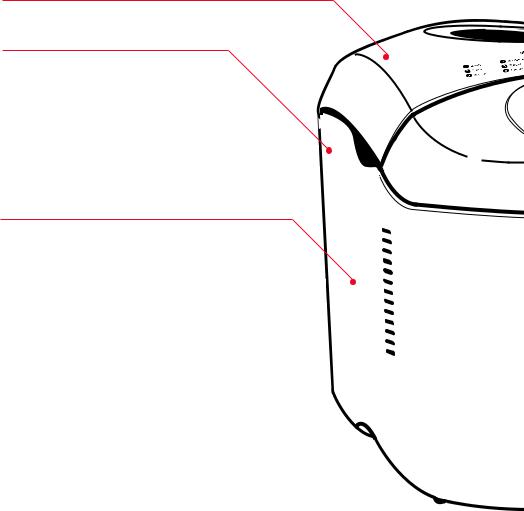
Getting to know your Bakehouse
Removable lid
Cool Touch body
600 watts of power
Non-stick removable bread pan
Vertical Loaf - 750g or 1kg
Makes a vertical shaped loaf of bread in 2 sizes.
60 minute Keep-Warm function
Keeps bread warm for 1 hour after baking.
15 hour Time Delay
Pre-set your breadmaker.
Fruit & Nut beeper
The Bakehouse beeps to let you know when to add fruits and/or nuts.
4
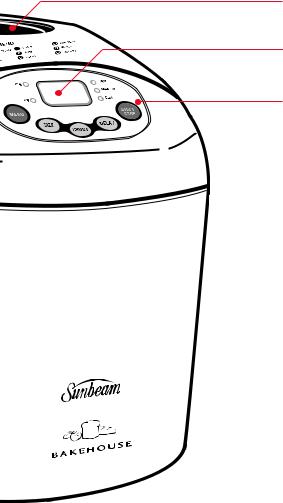
Viewing Window
Display Window
Multi-Option Control Panel
Power Interruption Program Protection
If there is a temporary power outage during use, the machine will retain its memory and continue the baking cycle when the power returns.
5
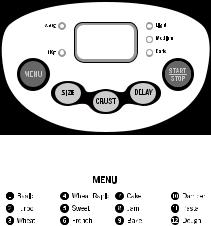
The Control Panel
Display window
Indicates the program setting selected from
(1) to (12) and the Crust Colour and Loaf Size until the Start button is pressed. The display will show the number of hours and minutes until the cycle is complete - “0.00”.
Menu button
Press this button to select the setting of your choice from (1) to (12). A beep will sound each time you press the button.
Delay button
Allows you to delay the beginning of your desired program setting. See page 13 for instructions on how to use the Delay bake function.
Crust colour button
Press to select the desired crust colour – Light, Medium or Dark.
Size Button
Press to select the desired loaf size, 750g or 1kg.
Start/Stop button
Press to commence selected setting or begin timer countdown for delay timer.
To stop the operation or cancel a timer setting, press and hold for 2-3 seconds until you hear a beep.
6
Program Settings
(1) Basic
Use this setting to make traditional white bread. You have a choice of 3 crust colours - Light, Medium or Dark. The Bakehouse lets you choose your favourite crust colour for most breads.
(2) Turbo
Use the turbo setting for ready made bread in approximately 2 hours. This setting lets you save time on the bread recipes by reducing the completion time and is ideal for when you need bread in a hurry. Breads made using this setting may be shorter and more dense due to the reduced rising time.
(3) Wheat
Whole wheat breads require more rising time to accommodate the slower rising action with whole wheat flour. Therefore, it is normal for whole wheat breads to be heavy and slightly dense in texture.
(4) Wheat Rapid
This setting decreases the completion time of whole wheat bread. Ideal to cater for last minute guests or when you need bread in a hurry.
(5) Sweet
This cycle is for breads that require additional ingredients such as sugar, dried fruits or chocolate to sweeten the bread. To prevent the crust from becoming to dark, the light crust colour is recommended.
(6) French
This cycle is for breads with crispier crusts, such as French and Italian breads.
(7) Cake
Make your favourite cakes or use packaged cake mixes to have warm home made cakes any time.
(8) Jam
Use fresh fruit to make sweet and savoury jams. Ideal to store and use all year round.
(9) Bake
Set the program to Bake for an immediate baking process.
(10) Damper
Make a traditional damper bread on this setting. The bread will have a heavier and denser texture than Basic bread.
(11) Pasta
This setting is used to prepare the dough for pasta. Feed the pasta through a pasta machine to make fettuccini, ravioli and lasagne.
(12) Dough
Use this setting to make dough only, so that you can knead and shape a variety of breads to bake in a conventional oven. Make dough for pizzas, dinner rolls and bread sticks.
7
Role of Ingredients
Yeast
Yeast is actually a microscopic plant. Simply stated, without yeast, your bread will not rise. When moistened by a liquid, fed by sugar and carefully warmed, yeast produces gases that power the dough to rise. If the temperature is to cold, the yeast will not be activated; if it’s too warm, it will die. Your Bakehouse takes care of this worry for you by maintaining just the right temperature in the baking chamber at all times.
Some yeasts may require the use of a bread improver. The Bread Improver will provide additional gluten to the flour to produce a better loaf.
Note: We do not recommend the use of fresh or compressed yeast in your breadmaker. Sunbeam recommend the use of dry yeast only. Always ensure it is used well within the use-by date, as stale yeast will prevent the bread from rising.
We suggest that a small pocket be made in the top of the dry mixture to hold the yeast. This will ensure its activation when in contact with the liquid and sugar during kneading.
Flour
In order for the bread to rise, the flour has to have a sufficiently high protein content. Sunbeam recommend the use of a good quality plain or bread flour.
Unlike white flour, wheat flour contains bran and wheatgerm which inhibit rising. Wheat breads therefore, tend to be heavier in texture and smaller in size. A lighter larger loaf can be achieved by combining wheat flour with white flour for whole wheat bread recipes.
Sugars
Sugars sweeten the bread, brown the crust, lend tenderness to the texture and supply the yeast with food. White or brown sugar,
molasses, maple or golden syrup, honey and other sweeteners may be used in equivalent quantities.
Artificial sweetener can be substituted in equivalent amounts, however the taste and texture of your bread will vary.
Liquids
When liquids are mixed with protein in flour, gluten is formed. Gluten is necessary for the bread to rise. Most recipes use powdered milk and water, but other liquids such as milk and fruit juice can be used. Experiment with quantities of these liquids to obtain optimum results. Liquids should be used at room temperature.
A recipe with too much liquid may cause the bread to fall during baking while a recipe with too little liquid will not rise.
Salt
In small amounts, salt adds flavour and controls yeast action. Too much salt inhibits rising, so be sure to measure amounts correctly. Any ordinary table salt may be used.
Eggs
Eggs are used in some bread recipes, they provide liquid, assist with the rising and increase the nutritional value of the bread. They add extra flavour and are usually used in the sweeter types of bread.
Fats
Many breads use fats to enhance the flavour and retain moisture. Typically, we use margarine in the recipes, softened butter or oil may be used in equivalent quantities.
If you choose not to add any fat, your bread may vary in taste and texture.
8
What Ingredients To Use
To achieve an optimum loaf of bread, always use fresh, quality ingredients.
Flour
A good quality flour (within its use by date) should be used. A high protein bread flour can also be used for bread making.
It is important to weigh the flour required for each recipe as flour naturally aerates. This will ensure a perfectly baked loaf.
Bulk packs of flour may be used, however the result of your bread may vary. The texture and height of the bread will be inconsistent if the flour is stored for long periods of time in unsatisfactory conditions. Purchase bulk packs of flour only if baking constantly.
Yeast
Bulk packs of dry yeast and dry yeast sachets are recommended.
Bread Improver
The use of Bread Improver is recommended for all recipes to achieve optimum results. Bread Improver will increase the gluten content of the flour mix. It will also influence the structure, size and texture of the bread, so that it does not collapse when baking. The suggested quantity to use is stated in all recipes. Bread Improver has a flour like texture and can be purchased through health food shops or through selected supermarkets.
Bread mixes
A variety of bread mixes can be used in your bread maker. Directions of use should be supplied on the bread mix packaging.
Some bulk bread mixes may require the use of a bread improver.
We recommend you contact the Bread Mix manufacturer for further information on the use of their product.
Hints
•Different brands of yeast, used with different brands of flour, will influence the size and texture of your bread. Experiment with these ingredients to determine which combination of ingredients gives you the best result.
•It is normal for breads to be inconsistent in height and texture even if you are using the same ingredients time and time again. This inconsistency is usually influenced by the natural varying protein levels of wheat in the flour.
9
Using your Bakehouse
1.Before using your Bakehouse for the first time remove the bread pan by gently pulling it out. Wipe over the bread pan and kneading blade with a damp cloth and dry thoroughly.
Do not immerse the bread pan in water unless necessary. Do not use harsh abrasive cleaners as they may damage the non-stick surface. Do not place any parts of your breadmaker in the dishwasher. Select a recipe from the recipe section and prepare the ingredients as directed. (See Important Measuring Tips on page 17).
2.Add the ingredients into the bread pan in the order listed. All ingredients should be at room temperature and measured carefully. Wipe all spills from the outside of the pan.
3.Insert the bread pan into the baking chamber of the bread machine. To do this, place the bread pan into the baking chamber so that the handle lines up with the two stainless clips on each side of the chamber. Apply pressure to push the baking tray downwards and it will click into place.
Lay the handle flat toward the side of the bread pan.
Close the lid securely, plug the machine into a 230-240 volt AC power outlet and turn the power ON.
Note: When the machine is first plugged in, the Display Window will beep and flash “0.00” until a program is selected.
4.Select the desired program setting, size and crust colour. Press Start. The Bakehouse will display the hours and minutes until the cycle is complete.
5.To remove the bread pan from the Bakehouse refer to text on page 11.
10
Select Program Setting
1.To select a program setting use the Menu button until the desired number of the program (from 1 to 12) is displayed on the control panel. Each time you press the Select button, a beep will sound.
2.Use the Size button to select the desired loaf size. At this stage, the Display Window will show the hours and minutes until the cycle is complete. This will change when the crust colour is selected.
3.Use the Crust Colour button to select your choice of crust colour. You are able to choose from the Light, Medium, or Dark crust colours on selected settings. See table on page 12. Unless you select a crust colour (where applicable) the Bakehouse will automatically default to a Medium crust colour.
Note: A choice of Crust Colours is available on most settings except for Program No.s (8), (9), (10), (11) and (12).
4.To start, press the Start/Stop button. The Bakehouse will beep and will display the hours and minutes until the cycle is complete.
To cancel operation at any time, hold the Start/Stop button down for 2-3 seconds. Avoid opening the lid at any time during the bread cycle unless adding fruits or nuts when indicated.
The table on page 12 illustrates the Program settings and Crust Colour options.
To add fruit or nuts
You are able to add fruit or nuts on settings
(1) Basic and (5) Sweet when you hear 8 short beeps (approximately 15-20 minutes into the cycle). Open the lid and add any fruits or nuts that the recipe requires as the machine is kneading. Close the lid and the Bakehouse will automatically continue the cycle.
On various settings the machine will beep approximately 50 minutes before the completion of bread to indicate the commencement of baking.
The machine will beep 5 minutes prior to the completion of baking.
At the end of the baking cycle the machine will beep and the display will read “0.00”. The Bakehouse will automatically switch to a Keep Warm cycle for 60 minutes. Warm air will circulate throughout the baking chamber, to help reduce condensation.
The bread can be removed from the baking chamber at the end of the cycle or any time during the Keep-Warm cycle. Simply press the Start/Stop button to end the Keep-Warm period and turn off the breadmaker at the powerpoint.
To remove the bread from the Bakehouse
The bread pan will be hot after the baking cycle. Use a kitchen mitt to remove the pan from the baking chamber. Gently pull the pan out.
11

Select Program Setting continued
Menu |
Setting |
|
Crust Colour |
|
Time |
Fruit & Nut |
750g |
1kg |
|
|
Delay |
Beeper |
|||||
|
|
|
|
|
|
|
||
|
|
|
|
|
|
|
|
|
|
|
LIGHT |
MEDIUM |
DARK |
|
|
|
|
|
|
|
|
|
|
|
|
|
1 |
Basic* |
|
|
|
|
|
|
|
|
|
|
|
|
|
|
|
|
2 |
Turbo |
|
|
|
|
|
|
|
|
|
|
|
|
|
|
|
|
3 |
Wheat |
|
|
|
|
|
|
|
|
|
|
|
|
|
|
|
|
4 |
Wheat Rapid |
|
|
|
|
|
|
|
|
|
|
|
|
|
|
|
|
5 |
Sweet* |
|
|
|
|
|
|
|
|
|
|
|
|
|
|
|
|
6 |
French |
|
|
|
|
|
|
|
|
|
|
|
|
|
|
|
|
7 |
Cake |
|
|
|
|
|
|
|
|
|
|
|
|
|
|
|
|
8 |
Jam |
|
|
|
|
|
|
|
|
|
|
|
|
|
|
|
|
9 |
Bake |
|
|
|
|
|
|
|
|
|
|
|
|
|
|
|
|
10 |
Damper |
|
|
|
|
|
|
|
|
|
|
|
|
|
|
|
|
11 |
Pasta |
|
|
|
|
|
|
|
|
|
|
|
|
|
|
|
|
12 |
Dough |
|
|
|
|
|
|
|
*Time delay is not recommended for Sweet or Basic breads that require fruits or nuts to be added.
Allow the bread to cool in the bread pan for 10 minutes before removing. Turn the pan upside down and shake until the bread slides out. If necessary, use a plastic spatula to loosen bread from the sides of the pan. Allow the bread to cool on a wire rack for at least 10 minutes before slicing. For easy slicing we recommend the use of an electric knife or a quality bread knife.
After using your Bakehouse, unplug the machine and allow it to cool for 30 minutes before commencing another program. If you attempt to use the Bakehouse too soon, it will beep and the display will read ‘E:01’, indicating the Bakehouse has not cooled sufficiently.
Press the Start/Stop and wait until the Bakehouse has cooled.
12
Using the Time Delay
The Bakehouse allows you to delay the cooking of your bread by up to 15 hours, so you can wake up to the smell of freshly baked bread, or go out for the day while your Bakehouse does all the work.
We strongly recommend you make a pocket in the top of the dry ingredients to hold the dry yeast. This will ensure that the yeast does not start activation before the program selected begins.
Note: Do not use the Time Delay when the recipe has perishable ingredients such as milk, eggs or cheese, as these will spoil.
Also, fruit and nuts should only be added manually. Do not use the Time Delay for recipes that require fruits and nuts to be added at a later time. If you do add them on the Time Delay, they will be excessively crushed during the kneading cycle. 1.Follow steps 1, 2 and 3 on page 10. 2.Press the Delay button until you reach the
number of hours and minutes from now that you want your bread to be ready.
3.Press the Start/Stop button to begin the cycle. The Timer will start counting down. The bread will be cooked and ready in the hours and minutes displayed.
Note: If you make a mistake, or need to reset the Timer, press the Start/Stop button for 2-3 seconds.
Example
Before leaving for work at 8am, you decide to set the Time Delay so that the bread or selected program will be ready and completed by 6pm when you return home - which is 10 hours later.
After following instruction 1 on this page, press the Delay button until the display reads “10.00”. Then press Start.
This tells you that your bread or selected program will be complete in 10 hours. The Bakehouse will begin counting down and your selected program will be complete by 6pm. Note: You do not need to take into account the amount of time required to cook the program selected. This is automatically registered in the Bakehouse when it is selected.
13

Turbo Setting
Need bread in a hurry? The Turbo setting is used to decrease the overall completion time of your bread. This is especially handy when you need bread in a hurry.
The breads made using this setting may be shorter and denser because of a decrease in rising times.
The Turbo setting should only be selected when baking White and Wheat breads.
To use the Turbo setting, put ingredients into bread pan and then place in the Bakehouse and select program setting (2) Turbo, then press Start.
Cake Setting
Make a variety of sweet and savoury home made cakes on this setting. You can use this setting to mix and bake cakes.
We recommend the use of pre-packaged cake mixes. Select the Light crust colour to prevent the sides from burning.
Refer to the Cake instructions in the Recipe section.
Jam Setting
You can now have fresh jam all year round. Use this setting to make fresh savoury and sweet jams.
Refer to the Jam instructions in the Recipe section.
14

Bake Setting
When you select the Bake setting, the Bakehouse will immediately start baking. This setting will bake for 1 hour and can be controlled manually by pressing the Start/Stop button to stop the function at any time. This setting can be used to complete the bread baking process in case of a power failure. If there has been a power failure, allow the dough to rise in the bread pan without power until it reaches 3/4 of the way up the bread pan.
Reconnect electricity and select program setting (9) Bake, and press Start.
Note: You may need to wait 10-15 minutes for the machine to cool down, before you select the bake program. If you attempt to use the Bake option before the machine has cooled down, an error message will appear on the display - ‘E:01’.
Damper Setting
Have traditional damper style bread ready in under 1 hour.
Refer to the Damper instructions in the Recipe section.
Pasta Setting
This program allows you to make pasta dough for fresh pasta. Feed the pasta through a pasta machine to make fettuccini, ravioli and lasagne.
Refer to the Pasta instructions in the Recipe section.
15

Dough Setting
This program allows you to create a variety of doughs for bread sticks, bread rolls and pizza to bake in a conventional oven.
Refer to the Dough instructions in the Recipe section.
Power Interruption Program
Protection
Your Bakehouse features a 10 minute Power Interruption Protection that protects the Program memory in the advent of power surges, or short term power failure (blackout).
This means that if there is a power interruption during your bread making, the machine will retain its memory for at least 10 minutes and continue cooking when the power supply returns. This feature is applicable whether the
machine is in the Kneading, Baking or Delay cycle.
Without this feature the machine would reset and the breadmaking cycle would stop.
If you experience a power failure greater than 10 minutes you may need to discard your ingredients and start again.
16
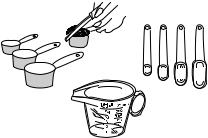
Important Measuring Tips
Each ingredient in a loaf of bread plays a specific role, so it is extremely important to measure the ingredients correctly to get the best results.
For optimum results, we recommend weighing ingredients on a kitchen scale. This is especially important with flour. Because flour aerates, an accurate amount is needed to achieve an optimum loaf of bread.
Weight measurements are given for each recipe. If kitchen scales are not available, ensure the following instructions are followed:
Dry ingredients
Use a metric measuring spoon or cup. Do not use tableware spoons or cups. Spoon the dry ingredients loosely into the spoon or cup and level off with a flat knife. This is particularly important with flour. Do not pack dry ingredients down into the cup or tap the cup unless otherwise stated in the recipe.
Liquids
Fill a metric measuring spoon or cup to the level indicated. Check your cup measurement by placing the measuring cup on a flat surface and reading the measurement at eye level.
Solid fats
Fill a metric measuring spoon or cups to the level indicated and level off with a flat knife.
Last Things Last
Always place the liquid in the bread pan first, the dry mix ingredients in next. Then, make a small pocket in the top of the dry ingredients and place the yeast in the pocket. Wipe away any spills from around the outside of the pan. This will ensure a well risen and evenly baked loaf.
Adding Fruits and Nuts
Fruits and nuts are added towards the end of the kneading cycle. The machine will beep to let you know it is time to add fruit or nuts. If they are added before the Fruit and Nut beep, the fruit will be pureed due to excessive kneading.
17
Handy Hints
Order of ingredients
Always put the liquid in first, the dry ingredients in next and the yeast in last. Fruits and nuts are added later, after the machine has completed the first knead. This will ensure a crisp and evenly baked loaf every time.
Freshness
Ensure all ingredients are fresh and used before the specified use-by date.
Avoid using perishable ingredients such as milk, yoghurt, eggs or cheese, with the Time Delay function.
Store dry ingredients in airtight containers, to prevent drying out.
Slicing bread
For best results, wait at least 10 minutes before slicing, as the bread needs time to cool. Place loaf on its side and cut in a sawing motion with a bread knife. For easy and even slicing we recommend the use of the Sunbeam Carveasy electric knife.
Freezing bread
To freeze fresh bread, let it cool completely and wrap in plastic. Slice bread before freezing and use at your convenience.
Like a cake, the bread needs to cool slightly before removing from the bread pan. Allow the bread to sit in the pan for approximately 10 minutes before removing.
If you remove the bread pan whilst it is still hot you must use an oven mit.
Toppings
Ingredients such as herbs, sesame seeds and chopped bacon can be added to the top of the bread during the baking stage.
Open lid of Bakehouse, gently brush top of loaf with a little milk or egg yolk and sprinkle with topping. (Do not allow ingredients to fall outside pan). Close lid and allow baking to continue.
Note: This step needs to be done quickly to prevent bread from sinking.
Crust colour
It is normal for the top of the bread to be lighter in colour than the sides. Different combinations of ingredients can encourage or discourage browning.
Baking at high altitudes
At high altitudes above 900 metres, dough rises faster. Therefore, when baking at high altitudes some experimentation is required. Follow the suggested guidelines. Use one suggestion at a time and remember to write down which suggestion works best for you.
Suggestions:
1.Reduce the amount of yeast by 25%. This will stop the bread from over-rising.
2.Increase the salt by 25%. The bread will rise slower and have less of a tendency to sink.
3.Watch your dough as it mixes. Flour stored at high altitudes tends to be drier. You may have to add a few tablespoons of water, until the dough forms a nice ball.
18
